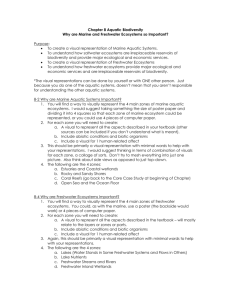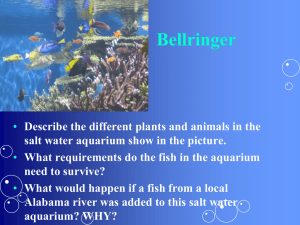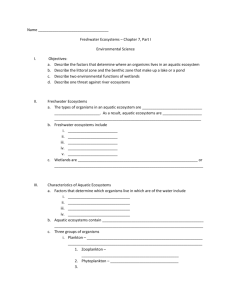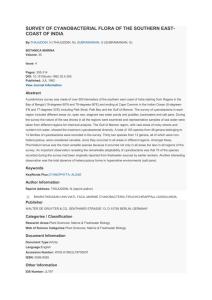8-2 Why are Marine Aquatic Systems Important?
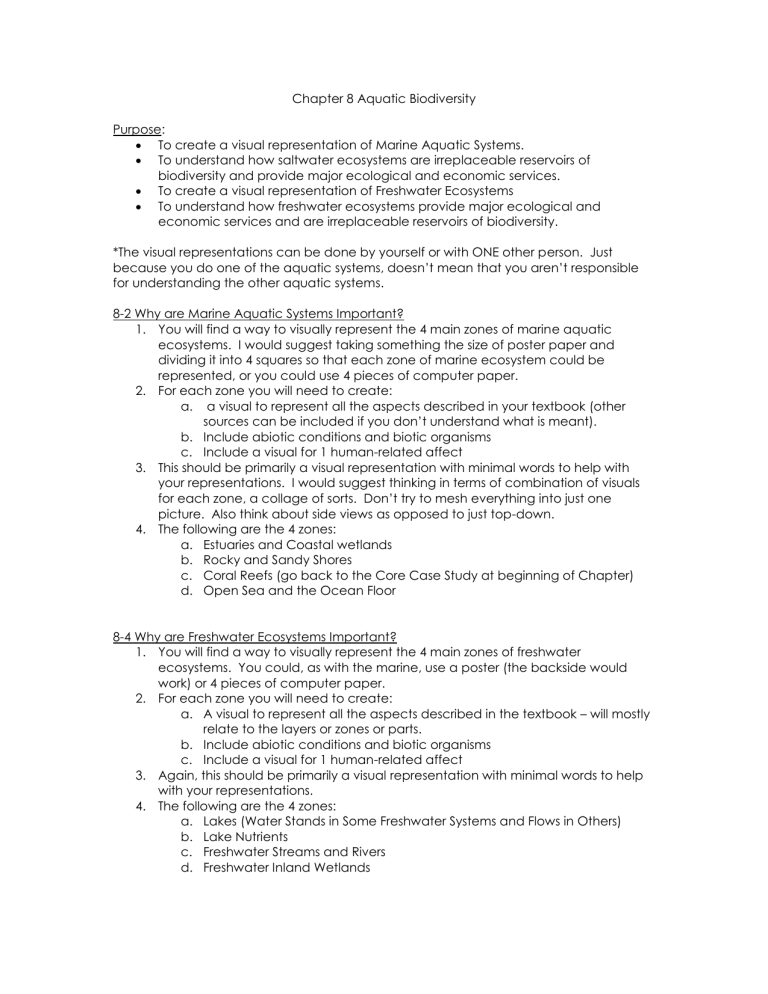
Chapter 8 Aquatic Biodiversity
Purpose:
To create a visual representation of Marine Aquatic Systems.
To understand how saltwater ecosystems are irreplaceable reservoirs of biodiversity and provide major ecological and economic services.
To create a visual representation of Freshwater Ecosystems
To understand how freshwater ecosystems provide major ecological and economic services and are irreplaceable reservoirs of biodiversity.
*The visual representations can be done by yourself or with ONE other person. Just because you do one of the aquatic systems, doesn’t mean that you aren’t responsible for understanding the other aquatic systems.
8-2 Why are Marine Aquatic Systems Important?
1.
You will find a way to visually represent the 4 main zones of marine aquatic ecosystems. I would suggest taking something the size of poster paper and dividing it into 4 squares so that each zone of marine ecosystem could be represented, or you could use 4 pieces of computer paper.
2.
For each zone you will need to create: a.
a visual to represent all the aspects described in your textbook (other sources can be included if you don’t understand what is meant). b.
Include abiotic conditions and biotic organisms c.
Include a visual for 1 human-related affect
3.
This should be primarily a visual representation with minimal words to help with your representations. I would suggest thinking in terms of combination of visuals for each zone, a collage of sorts. Don’t try to mesh everything into just one
4.
picture. Also think about side views as opposed to just top-down.
The following are the 4 zones: a.
Estuaries and Coastal wetlands b.
Rocky and Sandy Shores c.
Coral Reefs (go back to the Core Case Study at beginning of Chapter) d.
Open Sea and the Ocean Floor
8-4 Why are Freshwater Ecosystems Important?
1.
You will find a way to visually represent the 4 main zones of freshwater ecosystems. You could, as with the marine, use a poster (the backside would work) or 4 pieces of computer paper.
2.
For each zone you will need to create: a.
A visual to represent all the aspects described in the textbook – will mostly relate to the layers or zones or parts. b.
Include abiotic conditions and biotic organisms c.
Include a visual for 1 human-related affect
3.
Again, this should be primarily a visual representation with minimal words to help with your representations.
4.
The following are the 4 zones: a.
Lakes (Water Stands in Some Freshwater Systems and Flows in Others) b.
Lake Nutrients c.
Freshwater Streams and Rivers d.
Freshwater Inland Wetlands
8-3 How Have Human Activities Affected Marine Ecosystems?
8-4 How Have Human Activities Affected Freshwater Ecosystems?
Purpose
Understand how human activities threaten aquatic biodiversity and disrupt ecological and economic services provided by saltwater, freshwater lakes, rivers, and wetlands
Explore these human activities as they relate to Florida and Florida’s coastal areas.
1.
You may now work in a group of 4. Again, you are responsible for understanding all aspects as they are found in the textbook even though your group may only have a specific half assigned to you.
2.
You are your group are to create a small newspaper or newsletter (think The
Beeline or The Buzz) to educate us on the human activities affecting marine and freshwater ecosystems. This is to be an electronically generated project.
3.
You will need to create an “article” about the Natural Capital (economic and ecological services) provided by each ecosystem. The marine ecosystem services are on page 172 and freshwater on page 181.
4.
Each group will be assigned 4 activities related to the marine ecosystem and
2 related to freshwater. No matter what the activities are, you are to create articles as they relate to Florida and Florida’s coastal areas. This means you will need to do some research and find information on where this is happening in Florida. Within each of these articles we will need some kind of basic explanation of what the activity/issue is to begin with and then how it relates to a specific part of Florida and the problems occurring there.
EX – You might have coastal development as an activity. Within your article you’ll need a basic explanation of what the problem is and how/why this activity is a problem. Then you will research and learn of a specific place within FL where this is a huge problem. Maybe something about how there has been development on barrier islands and it ruins the dune ecosystem and all the organisms that use the dunes. You could also include how this causes problems for humans as we have more pronounced beach erosion and spend millions in beach replenishment.
Human impacts on marine ecosystems can be found on pg 178-179, and freshwater on pg 186. You will want to read through and get a little background info from the book first.
5.
Try to format this as a newsletter or newspaper would be. Play around with
Publisher or even Word (there’s options within Word that creates columns).
6.
Each group will be assigned a letter from A-E. The topics listed for each letter are what you are to address in your newsletter.
canals – fragment & reduce water flow
Flood control levees & dikes
– destroy habitats
Group A
Coastal development
Runoff – nonpoint sources
Point-source pollution
Pollution & degradation of coastal wetlands & estuaries
Dams and
Group B
Overfishing
Use of fishing trawlers
Invasive species
Climate change
Excess plant nutrients – eutrophication
Inland wetlands drained for crops or cities
Group C
Coastal development
Climate change
Point-source pollution
Use of fishing trawlers
Dams and canals – fragment & reduce water flow
Inland wetlands drained for crops or cities
Group D
Runoffnonpoint sources
Overfishing
Pollution & degradation of coastal wetlands & estuaries
Flood control levees & dikes
– destroy habitats
Excess plant nutrients – eutrophication
Group E
Runoff- nonpoint sources
Point-source pollution
Use of fishing trawlers
Invasive species
Excess plant nutrients – eutrophication
Inland wetlands drained for crops or cities
Visual Project Rubric
I will use the following criteria to grade your visual representations of the marine ecosystems and freshwater ecosystems.
Format (10):
Format
(see assignment)
5 points
Creativity/Neatness
5 points
Format is followed according to the directions given.
5 points
Exceptional, students strive for originality
5 points
Much of the format was followed, but some components are missing.
2-4 points
Project is creative and neat.
2 - 4 points
Students did not follow the directions for format.
0 - 2 points
Minimal creativity, apparently little effort made on presentation.
0 - 2 points
Content (35):
Accuracy
20 points
Clarity
5 points
Thoroughness/
Completeness
10 points
All content is accurate, and demonstrates mastery of the subject matter.
17-20 points
Material is written and displayed in VERY clear and understandable language.
5 points
ALL topics are addressed in a thorough but concise manner.
9-10 points
Most of the content accurate, with some misunderstandings and inaccuracies.
8-16 points
Topics are mostly understandable, but occasionally unclear or confusing.
2-4 points
Most components are included: some information may be left out.
4 - 8 points
Content is largely incorrect; shows major misunderstandings of the material.
0 - 7 points
Unclear; difficult to follow and understand.
0 - 2 points
Topic is inadequately discussed; incomplete work.
0 - 4 points
Newsletter Project Rubric
Projects will be graded according to these criteria unless a more specific rubric has been attached to your instructions.
Format and Presentation (10):
Format
(see assignment)
5 points
Creativity/Neatness
5 points
Format is followed according to the directions given.
5 points
Exceptional, students strive for originality
5 points
Much of the format was followed, but some components are missing.
2-4 points
Project is creative and neat.
2-4 points
Students did not follow the directions for format.
0 - 2 points
Minimal creativity, apparently little effort made on presentation.
0 - 2 points
Content (40):
Accuracy
20 points
Clarity
10 points
Thoroughness/
Completeness
10 points
All content is accurate, and demonstrates mastery of the subject matter.
17-20 points
Material is written and displayed in VERY clear and understandable language.
9-10 points
ALL topics are addressed in a thorough but concise manner.
9-10 points
Most of the content accurate, with some misunderstandings and inaccuracies.
8-16 points
Topics are mostly understandable, but occasionally unclear or confusing.
4-8 points
Most components are included: some information may be left out.
4-8 points
Content is largely incorrect; shows major misunderstandings of the material.
0 - 7 points
Unclear; difficult to follow and understand.
0 - 4 points
Topic is inadequately discussed; incomplete work.
0 - 3 points
